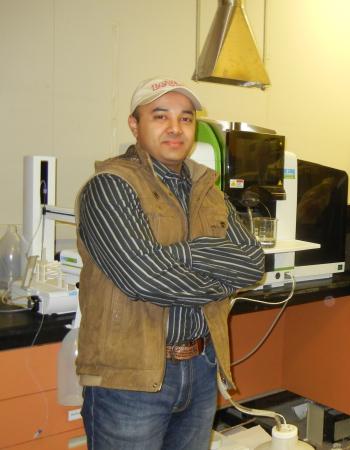Photocatalytic activity of graphene oxide/zinc oxide nanocomposite derived from rice husk for the degradation of phenanthrene under ultraviolet-visible light.
Environmental concerns have arisen due to the persistent nature and carcinogenicity of polycyclic aromatic hydrocarbons (PAHs). This study used the doping approach to successfully develop a nanocomposite photocatalyst based on graphene oxide (GO) and zinc oxide (ZnO). The nanocomposites were investigated by Fourier transform infrared (FTIR) spectroscopy, UV–Visible diffuse reflectance spectroscopy (UV–Vis DRS), x-ray diffraction (XRD), scanning electron microscopy (SEM) with energy dispersive x-ray (EDX), transmission electron microscopy (TEM), Brunauer-Emmett-Teller (BET), and Raman spectroscopy. GO/ZnO nanocomposite showed excellent ability to degrade 25 ppm of phenanthrene (86.06%) in 120 min under UV–Visible light exposure followed by photolysis (no photocatalyst) (15.56%), GO/ZnO without stirring (40.28%), GO/ZnO in the dark with stirring (47.40%), and commercial ZnO (62.84%). This is due to the largest surface area, which was enhanced by the doping of GO in commercial ZnO. Phenanthrene photodegradation by GO/ZnO nanocomposite followed first-order kinetics with a rate constant of 0.0375 min−1. The smaller byproducts like (Z)-3-hydroxy acrylic acid (1b; m/z = 88) and (Z)-4-oxobut-2-enoic acid (1c; m/z = 100) identified in GC–MS, clearly demonstrated e− excitement from encapsulated nanocatalyst followed by radical dotOH (active species) based oxidation of phenanthrene. Consequently, the GO/ZnO nanocomposite could be a versatile photocatalyst for the photodegradation of phenanthrene in wastewater treatment.

Skin cancer chemotherapeutics often lead to the development of severe cytotoxicity, compelling the development of novel delivery systems to not only enhance therapeutic efficacy but also minimize…

Biogas and natural gas are potential renewable energy sources. They primarily contain CH4, H2, CO2, CO, C2H6, C3H8, H2S, N2, and moisture. To be used as fuel, raw biogas and natural gas require…

A dimer of Pd(II), [(bpy)Pd(μ-OH)2Pd(bpy)]2+, (complex 1) (where bpy=2,2′-bipyridyl) has been synthesized at physiological pH (7.4) and characterized by electronic spectroscopy, electrospray…

